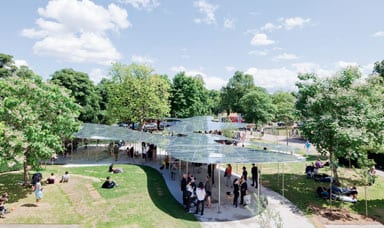
words Johanna Agerman
SANAA’s Summer Pavilion next to the Serpentine Gallery in London is like a giant spill of quicksilver, spreading between the trees of Kensington Gardens. The polished aluminium roof shows off a distorted reflection of the park. “It amplifies the beauty of the surroundings,” says Ryue Nishizawa, one half of Japanese architect SANAA. “Even the way people move looks very nice in this reflection.”
The roof is supported by stainless steel poles, the floor is cast in light grey concrete and the undulating walls are acrylic. A thick line of white shingle runs around its base. The pavilion plays on SANAA’s usual preoccupations with transparency, reflection and the monochrome.
As with many of SANAA’s buildings, this structure has no central point. Instead it sprawls in all directions and can be seen as a roofed promenade between the trees. This is a clever use of space and makes it seem as if nature is customised to the pavilion rather than the other way around.
“We started out with non-architectural ideas such as water, the rainbow and leaves to create the space. This is how we came up with the organic shape for the roof,” says Nishizawa. The roof varies in height from only 1 metre off the ground (“Like a table,” says Kazuyo Sejima, SANAA’s other partner) to 3.5 metres over the space that is used for talks in Serpentine’s Park Nights programme.
The pavilion is open to the public throughout the day and contains a little cafe for weary flâneurs. “It seems to have different uses to people throughout the day,” says Serpentine co-director Hans-Ulrich Obrist. “The joggers are our first visitors of the day, six or seven in the morning. With Olafur Eliasson and Kjetil Thorsen’s pavilion [2007] they were running up and down the ramp, with Frank Gehry’s [2008] they stretched against the pillars, but we still don’t know how they will appropriate the structure this year.”
The Serpentine Pavilion is SANAA’s first structure to be built on British soil and it is the ninth year of the Serpentine Gallery’s initiative to erect a temporary summer pavilion on its lawn, which started with Zaha Hadid in 2000.



















